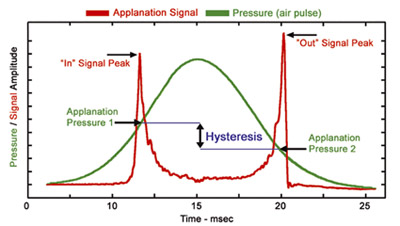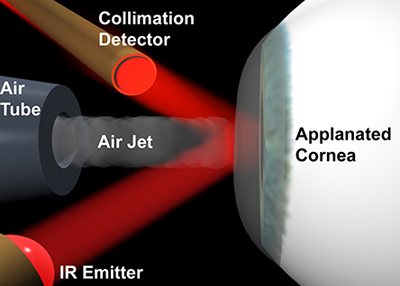
Reichert
Reichert Ocular Response Analyzer G3 (ORA)
Description
Experience the benefits of the Ocular Response Analyzer® (ORA) in glaucoma risk assessment and corneal assessment. This advanced device measures Corneal Hysteresis (CH) and Corneal Compensated Intraocular Pressure (IOPcc), providing valuable information beyond traditional measurements. Lower CH values have been associated with higher glaucoma risk, while IOPcc offers a more accurate indication of true intraocular pressure, less influenced by corneal properties. These measurements aid in treatment planning, identifying patients at higher risk, and assessing corneal biomechanics for refractive surgery candidates.
Product Features:
- Corneal Hysteresis (CH) Measurement: The ORA measures CH, which assesses the biomechanical properties of the cornea. It provides valuable information on glaucoma risk and progression, going beyond corneal thickness or topography.
- Corneal Compensated Intraocular Pressure (IOPcc): The device provides IOPcc, a more accurate indication of true intraocular pressure that is less influenced by corneal properties. This improves the assessment of glaucoma risk and helps set appropriate treatment goals.
- Clinical Significance: Studies have shown that lower CH is associated with a higher risk of glaucoma progression and faster rates of visual field loss. CH has been found to be even more significant than central corneal thickness (CCT) in predicting glaucoma progression, aiding clinicians in identifying high-risk patients.
- Improved IOP Measurement: Traditional tonometry methods like Goldmann tonometry are prone to errors due to corneal properties. The ORA's IOPcc takes into account corneal biomechanics, providing a better understanding of patient tonometry values and their association with glaucoma status.
- Comprehensive Corneal Assessment: The ORA allows clinicians to assess the cornea based on its biomechanical tissue properties, offering insights beyond geometric measurements. CH and the Corneal Resistance Factor (CRF) provide a comprehensive characterization of corneal properties, aiding in the assessment of conditions like keratoconus and post-refractive surgery cases.
Product Benefits:
- Glaucoma Risk Assessment: CH measurement helps identify patients at higher risk of glaucoma progression, allowing for more aggressive treatment and better management.
- Accurate IOP Measurement: IOPcc provides a more reliable indication of true intraocular pressure, reducing errors caused by corneal properties and improving treatment decision-making.
- Treatment Planning: CH measurement predicts the response to medical therapy, aiding in treatment planning and determining the most appropriate course of action.
- Enhanced Corneal Assessment: By considering corneal biomechanics, the ORA provides a comprehensive assessment of corneal properties, facilitating pre-operative evaluation of refractive surgery candidates.
Technical Details:
- Measurements: Corneal Hysteresis (CH), Corneal Compensated Intraocular Pressure (IOPcc), Corneal Resistance Factor (CRF)
- Clinical Validity: Supported by studies such as the Ocular Hypertension Treatment Study (OHTS)
- Corneal Conditions: CH and CRF measurements reflect changes in corneal biomechanics in conditions like keratoconus and post-refractive surgery
- Improved Glaucoma Risk Assessment: CH measurement is more significant than central corneal thickness (CCT) in predicting glaucoma progression
Click the "Get Pricing / More Info" tab to be contacted with further details
What is Corneal Hysteresis?
Corneal Hysteresis (CH) is the difference in the inward and outward pressure values obtained during the dynamic bi-directional applanation process employed by the Ocular Response Analyzer, as a result of viscous damping in the cornea. It is a characterization of the cornea?s energy absorption capacity, which is a function of the biomechanical properties of the cornea.
Ocular Response Analyzer is the only instrument in the world capable of measuring corneal biomechanical properties and Corneal Compensated IOP.

How it Works

The Ocular Response Analyzer is an advanced instrument that utilizes a dynamic bi-directional applanation process to measure the biomechanical properties of the cornea and intraocular pressure (IOP). During the measurement, a precisely metered air-pulse causes the cornea to deform and then return to its normal configuration. The electro-optical system continuously monitors the cornea's curvature throughout this process, collecting 400 data samples in just 20 milliseconds.
The Ocular Response Analyzer provides comprehensive pressure and cornea information, including:
1. IOPcc (Corneal Compensated IOP): This new IOP measurement is less affected by corneal properties, providing a more accurate assessment of intraocular pressure.
2. CH (Corneal Hysteresis): CH is a measure of the viscous damping in the cornea. It offers new indicators for disease diagnosis and management, particularly in relation to glaucoma.
3. CRF (Corneal Resistance Factor): CRF represents the total viscoelastic response of the cornea, providing additional insights into its biomechanical properties.
4. IOPg (Goldmann Correlated IOP): IOPg is the traditional IOP measurement that can be used for historical reference.
The Ocular Response Analyzer employs advanced technology with a patented dynamic bi-directional applanation process. This unique approach enables the direct measurement of corneal biomechanical properties, reducing operator variance through microprocessor control technology and objective measurement criteria.
The device is designed to be patient and operator-friendly. It does not require a chinrest, and the air puff used for measurement is soft and quiet, ensuring a comfortable and non-intimidating experience for patients. The instrument's fully automatic alignment and measurement capabilities provide fast and repeatable results, allowing any staff member to perform the exam.
The Ocular Response Analyzer comes with powerful software that enables automatic data capture for analyzing trends, evaluating treatment efficacy, and assessing diurnal variations. It also includes a comprehensive patient management database for easy record keeping. The software generates a detailed printout of the results, and the data can be exported for use in other applications if needed.
The Ocular Response Analyzer offers advanced technology, ease of use, patient comfort, and comprehensive data analysis capabilities, making it a valuable tool for assessing corneal biomechanics and intraocular pressure.




















